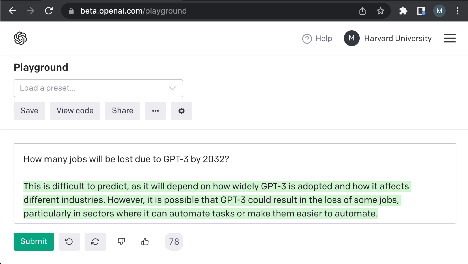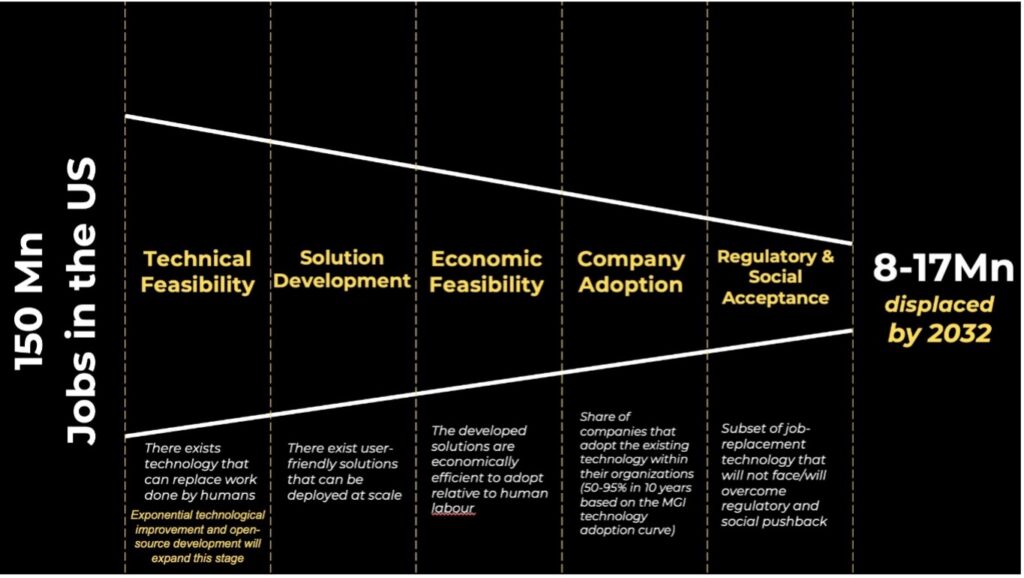By 2032, as many as 17M jobs in the US alone will be displaced by universal language processing models like GPT-3.

What Is GPT-3?
Generative Pre-Trained Transformer-3 (GPT-3) is a pioneering universal natural language model developed by OpenAI. It can generate sophisticated, human-sounding text in multiple forms — from poetry to prose to code.
How Does It Work?
Deep Learning models, like GPT-3 are loosely modeled on the pattern recognition process of neurons in human brains. By training on a vast amount of data (e.g., 1 trillion words on the internet), GPT-3 develops a mathematical map of human language to analyze any new input sequence and predict the next word in the sequence. By adding one word at a time, it’s able to generate entire paragraphs of text.
What’s So Special?
GPT-3 can produce output in multiple forms from professional emails to tweets to software code. This fine-tuning requires only a few new examples of a use-case(“few shot learning”). Progress has already been exponential – e.g., OpenAI released DALL-E, which takes in text and generates images. Experts speculate that language models, like GPT-3 could be the path to Artificial General Intelligence (AGI).
Users say that they can get a sensible response from GPT3 50-75% of the time. Accuracy will only continue to improve.

For this analysis, we built a robust model compiling 13K tasks across 700+ different occupations (99% of the 150M+ US jobs). We evaluated what tasks can be performed with GPT 3 based on both its currently demonstrated technological capabilities and the applications on which it will serve as a building block with further solution development in the next decade.
We identified the ones at risk as those in which over 50% of tasks performed on at least a daily basis can be performed by GPT3. We calculated total jobs displaced in the worst-case scenario by multiplying total US employment by the share of tasks performed daily that GPT3 can perform. For example, journalists who comprise 46.7K jobs will see 76% of their daily tasks displaced, i.e. as many as 35.7K jobs lost in the US.

Amplifying Factors
- Exponential growth in capabilities of language models fueled by reinforcement learning
- Rising cost of labour vs. declining cost of AI/ data/ compute
- Combination with other automation technologies (e.g., robotics)
Dampening Factors
- Regulatory and public pushback due to protectionist measures
- Rise of GPT-3 could create new jobs that don’t exist today and reduce overall magnitude of net jobs lost
- Slow company adoption due to privacy concerns and institutional factors limiting innovation and labor substitution
Additional support by both the regulatory and public private sector will be required to help displaced workers transition to good, viable roles. This includes reskilling and upskilling initiatives and social safety net improvements (e.g., relocation assistance, training grants, earned income tax credits, better income support programs).
Sam Altman, the optimist founder of OpenAI, has even recommended a form of universal basic income called the American Equity Fund to “ free Americans to work on what they really care about, improve social cohesion, and incentivize everyone to think about ways to grow the whole pie.”
Sources
- O*net https://www.onetcenter.org/database.html for job and task-level information Bureau of Labor Statistics for US employment statistics:
- https://blog.samaltman.com/american-equity
- https://www.nytimes.com/2020/11/24/science/artificial-intelligence-ai-gpt3.html
- https://analyticsindiamag.com/5-jobs-that-gpt-3-might-challenge/
- https://beta.openai.com/playground
- https://openai.com/blog/dall-e/




0 Comments